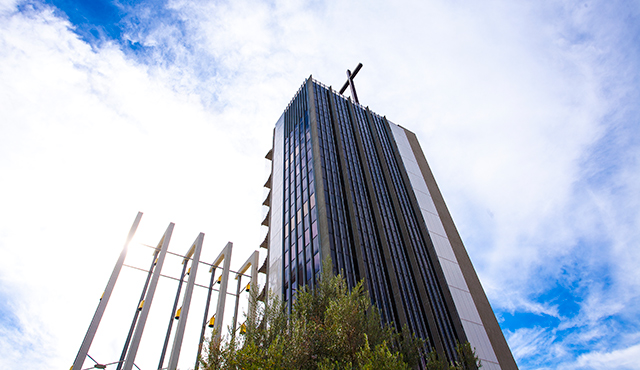The iconic 250-foot Tower of Hope designed by famed mid-century architect Richard Neutra was honored recently by the prestigious American Society of Civil Engineers for its seismic upgrade work.
Recognized as one of Neutra’s historically significant buildings, the Tower of Hope was built in 1968 by the Rev. Robert H. Schuller and immediately became a world-renowned landmark. For 10 years, the tower, topped by a 90-foot neon cross, was the tallest building in Orange County.
The tower has a narrow footprint, a 13-story exterior staircase open to the elements and an exterior glass elevator that offers dramatic views of the Orange County landscape. It was named for Hope Ministries, the nation’s first 24-hour suicide prevention hotline, 714-NEW-HOPE – a ministry that continues today.
Yet when the Diocese of Orange began considering the required upgrades to help the 50-year-old building withstand earthquakes, both architects and engineers were flummoxed. The common practice of stabilizing concrete buildings involves reinforcement with exterior concrete or even the addition of concrete stabilizers to the center interior. Costs were so prohibitive that it seemed the safest and most logical solution would be to tear down the tower and replace it with an earthquake-safe replica.
“Not on my watch,” says longtime Diocese of Orange volunteer Robert Neal, managing partner of Hager Pacific, who serves on the cathedral’s architecture board. “That would be like demolishing a Renoir. But there was no way to solve the problem with traditional engineering. A lot of people weren’t betting on us.”
Thanks to the imagination and creativity of the team led by LPA Inc., one of the largest integrated design firms in California and Texas, the renovations were made possible using new technology to rescue the structure and make it earthquake-safe. LPA brought together experts from many disciplines to address the unique problems posed by the tower project, including architects, structural engineers and historic preservation experts.
Bryan Seamer, an LPA associate and the firm’s director of structural engineering, notes that the technical challenges of the Tower of Hope renovation project required a collaborative team of partners knowledgeable in historic architecture as well as new technology.
“We spent a lot of time together, many hours on the site, and we were on call 24/7,” Seamer recalls. “In effect, we were designing on the fly.” That was because it was impossible to locate the rebar embedded in the original concrete so that the fluid viscous dampers – like large-scale shock absorbers – could be safely added on selected floors to reduce shaking in the event of an earthquake. Testing to locate the hidden metals involved ground-penetrating radar, scanners and more, Seamer notes.
He was proud to help preserve a building designed by Neutra, whom he calls “one of the titans of 20th century architecture – someone who is on the Mount Rushmore of mid-century architects. This was one of the later designs in his career where he collaborated with his son Dion. It’s an important piece of architectural history.”
The latest honor from ASCE is the sixth award honoring the Tower of Hope project, Neal says. Awards have recognized every facet of the project, including civil and structural engineering, historic preservation, documentation and more. Other honors include The American Institute of Architects’ Excellence in Engineering award and DOCOMOMO’s 2016 Modernism in American award.
While the architectural team was using innovation and creativity to solve structural challenges, they also were dedicated to modernizing the Tower of Hope for practical and liturgical use, Neal notes. In fact, as a working building, “every inch is taken” by cathedral offices and other church-related uses.
The Tower of Hope is home to the West Coast studios of EWTN, the global Catholic television network; the Immaculate Heart Radio studios, where some Orange County Catholic programs are broadcast; and a series of various outside ministries, such as the Augustine Institute and Jesuit philosopher Fr. Robert J. Spitzer’s Magis Center.
The second floor is home to the New Hope Crisis Center, a faith-based, ecumenical program of Catholic Charities of Orange County. The center continues the telephone hotline founded by Dr. Robert H. Schuller, who began the program following the heartbreaking suicide of a congregation member in what was then the Garden Grove Community Church.
“All of the buildings on the Christ Cathedral campus are remarkable,” Neal says. “The Tower of Hope is a fine example of mid-century modernistic architecture. It has a minimum of adornment, clean lines, lots of glass, and the use of formed concrete in the brutalist style. With tremendous light and space, it appears to be floating or soaring.”
The tower is a unique design among Neutra’s many buildings, Neal adds, which included office buildings, military academies, schools, apartment buildings, foreign embassies, private homes and European villas. The Austria-born architect spent much of his life in California and was well-known for the close attention he paid to the needs of his clients.
Neutra’s son Dion has kept the Silver Lake offices designed and built by his father open as Richard and Dion Neutra Architecture. The Neutra Office Building is listed on the National Register of Historic Places.

